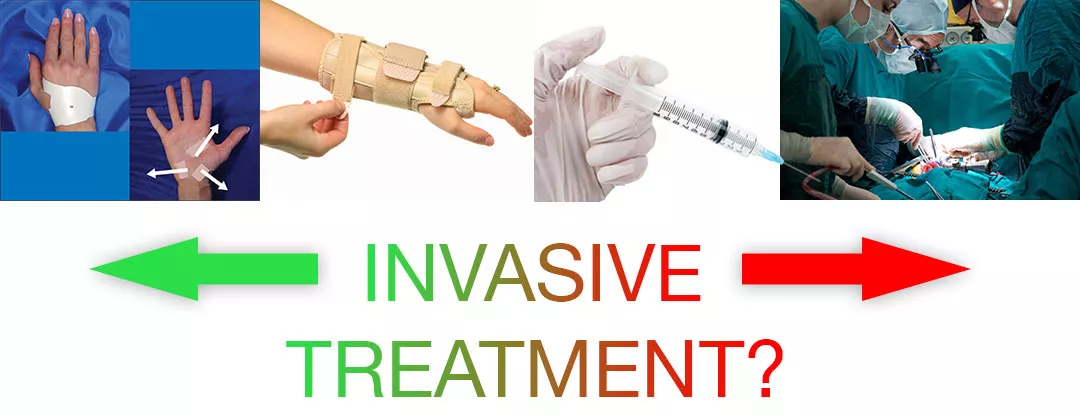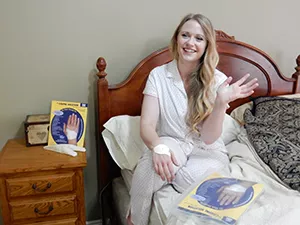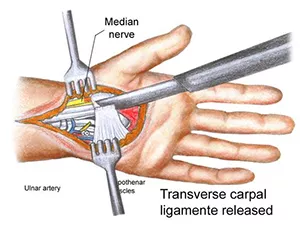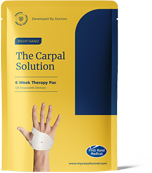


It is generally agreed across all medical circles that the best approach to treating almost any medical condition that is not life threatening, is to proceed with the least invasive treatment regimens that have a high success rate first, and then proceed to progressively more invasive procedures as necessary.
“Less invasive” “Least Invasive” or “Minimally Invasive” are terms used in medicine to describe treatment protocols and surgical procedures that involve less risk to the patient, less invasion of the body, less damage to surrounding organs and tissue, less loss of blood, lower costs and quicker recovery times.
However, the least invasive medical treatment options usually do not involve surgery at all. They are performed in the comfort and convenience of home.
Health Experts favored these home therapies because they reduce the burden on the health care delivery system and speed recovery for the patient. These least invasive treatments are usually administered by the patient or family member and therefore offer the least risk, the least downtime and the least overall costs to patients and the system.
An example is like removing a wart at home with a kit from Dr. Scholl’s rather than going to a specialist for surgical removal of the wart.
So, the best treatment options as defined by the medical profession, are those that can be done at home, are least invasive, with little or no risks and have a high patient success rate. Where possible medical procedures are moving toward this least invasive model to lower costs and lessen the burden on the health care system and expand viable treatments to more people.
So, applying this thinking to evaluating the treatment options for Carpal Tunnel Syndrome (CTS), here is what you have:
 The Carpal Solution Therapy is non-invasive and also has a high success rate with patients. Patients can use it in the comfort of home during sleep without having to worry about any potential complications, nor any risks and with no downtime. The patient can apply it themselves. For these reasons, The Carpal Solution is considered the best treatment for someone suffering with CTS. It is the least invasive treatment available and the Carpal Solution Therapy works for 97% of people. Neurologists call the Carpal Solution the best first line of defense for CTS.
The Carpal Solution Therapy is non-invasive and also has a high success rate with patients. Patients can use it in the comfort of home during sleep without having to worry about any potential complications, nor any risks and with no downtime. The patient can apply it themselves. For these reasons, The Carpal Solution is considered the best treatment for someone suffering with CTS. It is the least invasive treatment available and the Carpal Solution Therapy works for 97% of people. Neurologists call the Carpal Solution the best first line of defense for CTS.
A rigid hand brace is a low invasive device, but has a low success rate too. In fact, these rigid braces usually make CTS worse over the long run even though they reduce some pain in the first few days due to immobilization and minimizing movement. Wearing a rigid brace of any kind leads to muscle atrophy over time. Also, the rigid part of the device pressing against the soft tissue can injure the soft tissue further. Patients report that these devices are restrictive and make it hard to function normally. They also say people are always asking what is wrong.
So, even though the wrist splints and rigid hand braces are low on the invasive scale, there are still risks and they do nothing to promote healing, so these do not represent a good way to treat Carpal Tunnel.
How about Steroid Injections? Steroid injections are more invasive than braces and they carry more risks, but they only work 50% of the time for patients and the benefits of a steroid injection are short lived. Most patients report that if it works, it eliminates the symptoms for only 2 to 3 months after a steroid injection. Then the Carpal Tunnel Symptoms come back. Steroid injections also carry more risks. Medical text books suggest that a patient should not undergo more than two steroid injections in any one joint. Animal studies have shown that repeated steroid injections have led to joint deterioration. Not a good result.


ORDER THE CARPAL SOLUTION TODAY
The ONLY treatment for carpal tunnel that comes with a no questions asked money-back guarantee and in-house dedicated pain relief team.
There are other risks associated with an injection in the wrist. A nerve or a tendon could be struck with the needle causing damage to the nerve or tendon. The tendon would heal, but nerves often do not heal if penetrated by a sharp object like a needle or scalpel. It can result in permanent nerve damage, so it is important to make sure the person administrating the injection knows what they are doing and precisely where to do the injection. Other risks with injections are: infections due to a non-sterile needle and the spread of blood borne diseases from contaminated serum.
What about Surgery for Carpal Tunnel?
Carpal Tunnel Release Surgery represents the most invasive and highest risk treatment option for people suffering with Carpal Tunnel. Carpal Tunnel Surgery of any kind has left patients somewhat cold.
 That is because it only works for 50 – 60% of people based on patient surveys. Even after a successful surgery, Carpal Tunnel Symptoms come back within 6 months to 10 years for most patients. People are usually surprised when they wake up one night to reoccurring Carpal Tunnel Symptoms. What they thought was a permanent fix, turns out to be only a temporary relief for CTS.
That is because it only works for 50 – 60% of people based on patient surveys. Even after a successful surgery, Carpal Tunnel Symptoms come back within 6 months to 10 years for most patients. People are usually surprised when they wake up one night to reoccurring Carpal Tunnel Symptoms. What they thought was a permanent fix, turns out to be only a temporary relief for CTS.
Repeat or Second surgical procedures for any ailment carry a much higher risk profile, because of the formation of scar tissue and the overall weakening of the surrounding tissue and joints during the first surgery. Many surgeons will not perform a second surgery of any type for this reason.
There are many risks associated with any surgery including Carpal Tunnel.You can learn more about those risks here.
Probably the biggest risk of Carpal Tunnel Surgery is that it returns and second surgical procedures or repeat Carpal Tunnel Surgery is then a prospect. The good news for someone suffering from CTS is that The Carpal Solution Therapy works for most people even after surgery. You must wait at least two month after surgery before applying the Carpal Solution Therapy.
When undergoing any kind of treatment it is good to know the potential downside and risks. Most medical professionals tend to down play the risks of their profession because they live with the risks every day and it is human nature to down play risks we deal with every day.
 Laparoscopy is an example of one of the first minimally invasive surgical procedure done through one or more small incisions (often less than a quarter of an inch), using small tubes and miniature scalpels and surgical instruments, with tiny video cameras that allow the surgeon to see what he is doing below the skin surface without exposing the patient to a large incision.
Laparoscopy is an example of one of the first minimally invasive surgical procedure done through one or more small incisions (often less than a quarter of an inch), using small tubes and miniature scalpels and surgical instruments, with tiny video cameras that allow the surgeon to see what he is doing below the skin surface without exposing the patient to a large incision.
There are two types of Surgical Procedures for Carpal Tunnel: Endoscopic Surgery (similar to the Laparoscopic Surgery described above) and the Open Carpal Tunnel Release Surgery. Both have higher risks than the other treatments listed above and are considered most invasive of the treatment options available.
There is some discussion about which procedure is most invasive. Some believe that Endoscopic Carpal Tunnel Surgery represents less risk compared to the open Carpal Tunnel Surgical Procedure.
However, there are risks to which the patient is exposed with the endoscopic procedure that they are not exposed to with the open procedure. Since everything is so compact in the Carpal Tunnel there are much higher risks of nicking the Median Nerve with the scalpel when performing the “less invasive” endoscopic procedure. Any contact of the Nerve with the scalpel will likely lead to permanent nerve damage of some kind for the patient.
This is why some surgeons refuse to perform the Endoscopic Procedure for Carpal Tunnel Surgery. There are also many tendons that run just under the transverse carpal ligament next to the Median Nerve, that are sometimes accidentally nicked by the scalpel during the procedure. Tendons will heal, but it can complicate recovery times when a tendon is compromised during Carpal Tunnel Surgery.
There is less tissue disturbed with the endoscopic procedure and smaller incision that need to heal, so if all goes well, the recovery time is faster with endoscopic surgery. However, if the Nerve is inadvertently struck by the scalpel then all bets are off for a speedy recovery with the endoscopic procedure.
Given these results it is hard to say which surgical procedure is least invasive. Both have their advantages and disadvantages from an invasive perspective.
Learn more about Carpal Tunnel Surgery
In Summary, the least invasive treatment for CTS is the Carpal Solution Therapy. Neurologists call it the best first line of defense for this hand /wrist condition, because there are no risks of complications and it is the best way to manage a chronic syndrome that returns every so many years. Most people find their symptoms go into remission for two to seven years after completing the Six Week Protocol developed by the Doctors. Least invasive measures are always better if they have a high success rate.

ORDER THE CARPAL SOLUTION TODAY
The ONLY treatment for carpal tunnel that comes with a no questions asked money-back guarantee and in-house dedicated pain relief team.
 The Carpal Solution is FDA registered and made in a FDA registered facility.
The Carpal Solution is FDA registered and made in a FDA registered facility.



